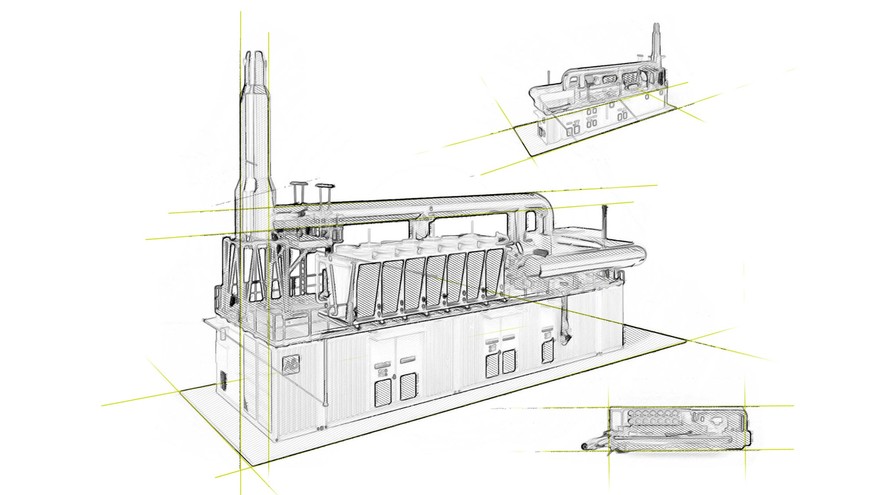What is cogeneration and why is it worth implementing in your company?
Cogeneration, also known as combined heat and power (CHP), is an effective solution that enables the simultaneous production of electricity and useful heat in a single process. This approach significantly increases energy efficiency in industrial companies, reduces CO2 emissions, and lowers operating costs. Let's explore its types, along with the most important advantages and disadvantages.

Cogeneration can utilize various energy sources. The most popular is gas cogeneration, which is based on natural gas. This is one of the most efficient and environmentally friendly solutions, as natural gas is characterized by low pollutant emissions. Another type is cogeneration based on solid fuels, such as coal, biomass, or waste. This solution varies in terms of environmental performance, depending on the fuel used, and is characterized by lower efficiency. Additionally, there is cogeneration based on liquid fuels, where heating oils are most commonly used. This option is less popular due to higher costs and greater pollutant emissions.

In this article, we will focus on high-efficiency gas cogeneration, which offers the greatest benefits among those mentioned earlier. A cogenerator consists of two basic elements: a drive device and an electric generator. The drive device can be an engine with an internal combustion chamber (e.g., a popular diesel engine adapted to burn gas) or a gas turbine. In both variants, the drive is used to power the electric generator. The electrical output is usually 40-45% of the rated power of the engine or turbine. The efficiency of heat production by the entire cogeneration system is about 45%. To achieve such a high result, heat recovery systems are used, capturing heat from the engine casing (with a temperature of about 80-90˚C) as well as energy recovery from exhaust gases (with a temperature of 300-600˚C).
Advantages of Cogeneration
The use of cogeneration systems, which combine the production of electricity and heat, as the name suggests, brings a dual benefit. Firstly, it allows for a significant increase in energy efficiency by utilizing heat that would otherwise be wasted in traditional power plants. The cogeneration process involves the useful application of heat generated during the process of electricity production in a gas engine.
As a result, companies can significantly reduce their energy bills, leading to lower operating costs. Additionally, cogeneration contributes to the reduction of CO2 emissions, which is particularly important in the context of increasing environmental regulations. Moreover, such a system can easily be powered by biogas or biomethane, enabling the generation of green energy with high efficiency. Another advantage is increased energy independence, as companies that produce their own energy are less dependent on external suppliers, thereby enhancing their energy security. Companies using cogeneration become partially independent from electricity supplies from the grid.
Cogeneration enables the achievement of very high efficiency in utilizing the energy contained in fuel, minimizing losses compared to the separate production of electricity and heat. The implementation of cogeneration, along with the accompanying modernization of power sources, is an attractive investment that consistently brings significant savings. Our experience shows that the payback period for such an investment is usually around 3-4 years. - comments Dr. Eng. Piotr Danielski, Vice President of DB Energy.
A typical cogeneration system with a capacity of up to 1 MW does not take up much space. The entire unit (drive and generating) can be placed in a soundproofed container with dimensions of about 3x12 m. The same container also contains accompanying installations, i.e.: electrical power switchboards, heat exchangers and coolers, which maintain the appropriate engine temperature in the event of a lack of heat collection.
Disadvantages of CHP
Despite its numerous advantages, cogeneration also has some drawbacks. One of the main challenges is the high initial cost associated with installing a cogeneration unit, which may be a barrier for some companies. Additionally, cogeneration requires advanced technology and proper management, which can be a challenge for companies lacking the necessary technical expertise. Precise planning and optimal system adjustment to the specific needs of the company's operations are also crucial to fully utilize the benefits of cogeneration.
Where will cogeneration work best?
Cogeneration is most effective in companies with a constant and high demand for electricity and heat. Examples of such companies include industrial plants with significant heat requirements, such as those in the chemical, food, or paper industries. In particular, cogenerators are well-suited for companies that utilize both hot water and steam in their technological processes.
Trigeneration - a step further in energy efficiency
Trigeneration is an extension of the cogeneration concept, involving the simultaneous production of electricity, heat, and cooling. This approach is particularly beneficial in places with high cooling demand, such as data centers, commercial facilities, or hotels. Trigeneration allows for even greater energy efficiency and financial savings.
Cogeneration is a forward-looking solution for industrial companies seeking to increase energy efficiency and reduce operating costs. Gas cogeneration, with its efficiency and environmental friendliness, is one of the best available solutions. Despite the challenges associated with installing a cogeneration system, the benefits far outweigh the disadvantages. If your company requires stable and efficient energy sources, implementing a cogeneration system is worth considering.